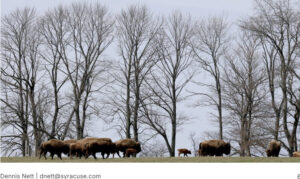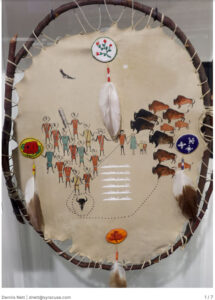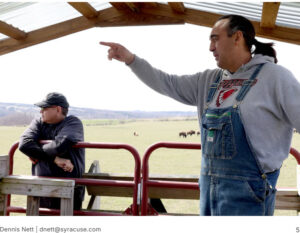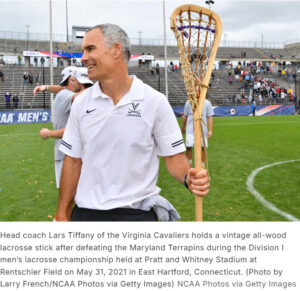 Onondaga Nation — Visitors to Virginia men’s lacrosse coach Lars Tiffany’s Charlottesville brick colonial house are confronted with a curious sign at the doorstep.
Onondaga Nation — Visitors to Virginia men’s lacrosse coach Lars Tiffany’s Charlottesville brick colonial house are confronted with a curious sign at the doorstep.
The thick wood is painted in big, bold letters.
“Buffalo for sale.”
No, Tiffany is not breeding calves between lacrosse seasons. The sign is a reminder of his upbringing.
It used to reside at the end of a long driveway on the Cherry Valley Turnpike (US Route 20) in LaFayette, New York, where Tiffany’s father Brad owned a 250-acre buffalo ranch. In 1973, Brad gave the neighboring Onondaga Nation 11 buffalo to start a herd.
Now, nearly 100 buffalo roam Onondaga pastures.
They live on 65 acres of land in the southwest corner of the Onondaga Nation. And just weeks ago, the herd welcomed a new crop of calves. About 10 calves are born each year, said Delphine Shenandoah, one of a group of Onondagas that tend to the herd.
The buffalo provide peace to the Onondagas who work with them. They also provide a link to the past and the future.
An Onondaga prophecy foretold of the day buffalo would return.
Brad’s transfer fulfilled it.
“They used to be part of us, and they were just killed off,” said Oren Lyons, the 95-year-old Haudenosaunee Faithkeeper. “So we brought them back. And Lars Tiffany is a big deal of that.”
Tiffany learned lacrosse from the Onondagas, graduated from LaFayette High School and coached the Haudenosaunee Nationals at the 2023 World Lacrosse Championships. He started his collegiate coaching career at Le Moyne.
Though Tiffany hasn’t lived in Central New York since the 1990s, and his family no longer owns the ranch, he has preserved his connection to the area he grew up in and the people he grew up with.
Last year, on the 50th anniversary of the agreement between his father and the Onondagas, Tiffany returned the original treaty Lyons drew up on deerskin. It’s now displayed on a two-year loan at the Skä•noñh Center, a Haudenosaunee cultural center on Onondaga Lake in Liverpool.
The buffalo population in North America fell from 60 million to mere hundreds by 1890 as part of the U.S. government’s policy to control indigenous people. While the buffalo are most known for roaming the Great Plains, they resided in Upstate New York as recently as the Revolutionary War, Dr. Paul Steblein told The Post-Stan dard in 1990.
dard in 1990.
There is a deep spiritual bond between indigenous people and the buffalo, Lyons said. Americans tried exterminating them both.
Brad wanted to remediate that problem. He bought 17 buffalo in 1968 from the National Bison Range in Montana and transported them to his ranch. By 1973, his herd of 52 was the largest east of the Mississippi River, per Agricultural News.
That same year, the Onondagas and Brad made the arrangement.
Lars Tiffany has been connected to the buffalo for longer than even he can remember.
A story his family has told him over and over again centers on his 3-year-old self.
As Tiffany tells it, he sat on the tractor with Brad to load hay when Brad noticed that the buffalo were near the family’s barn, with the doors slightly ajar.
Shoo the buffalo away, Brad told him.
So the toddler hopped off of the tractor and tried to wave them off.
“Shoo, buffalo, shoo!” he yelped. “Shoo! Shoo!”
Brad had just finished loading the truck, but his son was nowhere to be seen. He looked out the barn doors, and there his son was, right in the middle of a herd of 1,000-pound behemoths.
Brad’s voice hushed to a whisper as he coaxed Tiffany back to the tractor. Then he gave him a big hug.
“People are like, ‘Oh, this is the UVA lacrosse coach,’ ‘’ Tiffany told syracuse.com. “I’m like, ‘I’m a bison rancher.’ ”
As Tiffany grew, so did his duties with the buffalo. By 12, he was driving the tractor. By 13, he was responsible for distributing the hay across the pasture. From middle school until after he had graduated college and taken a job in California, Tiffany spent his summers at the ranch, baling hay, fixing fences and killing burdock.
Brad kept the herd for breeding purposes, but when it came time to cull it, a good-sized bull would yield almost 1,000 pounds of buffalo meat, Tiffany said. The family kept a walk-in freezer stocked with it. They prepared it in every way: bison burgers, buffalo steaks, kabobs, roasts and meatloaf.
Tiffany’s mother, Faith Corwin, collected buffalo hides when the herd shed theirs in the spring and made artwork with them. A few buffalo hide rugs and taxidermied buffalo heads adorned the Tiffany’s home.
But controlling the buffalo was not easy.
If the fences holding them in weren’t built strong enough or high enough, they’d plow right through.
“We were good stewards,” Lars Tiffany said. “And I think the Onondaga people are even better stewards. They’re building better fences, because I remember those first few years, the buffalo were out all the time. When you got the call from the state trooper, you were really hoping you could say, ‘Our buffalo are home, check the Onondaga buffalo. Maybe it’s their buffalo that are running around Onondaga County.’”
Tiffany has fond memories of Corwin leading the herd of buffalo back to the ranch, dropping apples for them as she walked.
“It felt like ‘Mission Impossible,’ ” Tiffany said.
There are several explanations for the buffalo’s calming shift, said Parker Booth, who helps tend to the herd.
The pasture where they graze is mowed now, which means fresh grass is available without the need to bust down a fence in search of more of it. And Booth has been diligent about any fences that need repair.
Maybe leadership is less inquisitive now, he said. The lead cow, or female buffalo who leads the herd, changes with the generations.
The Onondagas also believe the buffalo have “blood memory,” which is why the older buffalo were more likely to leave the pasture — in search of the same pastures their ancestors were — while the current generation is used to its space.
“They’re pretty quiet (now), that’s knock-on-wood,” Lyons joked. “Spent a good part of my young life chasing them around, getting them back in.”
In the early years of the Onondagas’ tenure with the herd, Brad hosted Lyons and a large group at his restaurant Scotch ‘N Sirloin in Syracuse, with chiefs, clan mothers and more in attendance. Bison wasn’t on the restaurant menu, but this was a special occasion, so he served everyone buffalo steaks, culled from his own herd.
Leon Shenandoah, the leader of the Haudenosaunee Confederacy at the time, received his steak and took a whiff.
“Hmm, I can smell the burdock,” he told Brad, in a story Lars Tiffany recounted.
Tiffany remains close with many of the Onondagas he grew up with and went to high school with at LaFayette. He calls former Cornell goalie Joe Solomon a best friend and stays with former Nazareth midfielder Brad Powless when he visits home.
For years, the treaty Lyons gave to Brad in 1974 to mark the transfer of the buffalo resided at Tiffany’s house. It is one of only a few treaties the Onondagas signed with non-indigenous people in the 20th century. Lyons drew it on deerskin stretched between ironwood bows, and it depicts the 11 buffalo, the Tiffany family and 14 Onondaga chiefs.
The original agreement stipulated that the Onondagas would return the 11 buffalo to Brad in six years — signified by six snowscapes drawn on the deerskin — but Brad never held them to that. Though the herd started off slow, it’s grown so much in recent years that the Onondagas have been able to help other nations, like the Seneca, start their own herds.
“My father had said, ‘Instead of giving us the buffalo back, if you want to give bison to other tribes, feel free,’ ” Tiffany said. “That essentially satisfies the contract.”
The Onondagas’ herd has grown to as large as 140 at times. But that didn’t afford the animals enough space, said George Thomas, who helps tend to the herd. The current size of about 90 is right where they want it.
Though commercializing the buffalo is antithetical to the ideals of why the Onondagas keep the herd, Booth said it would be nice to break even and cover the costs of upkeep on the farm.
Booth would like to make some capital improvements to update the farm’s infrastructure. Pieces of the tarp roof on one of the sheds are blowing away into the pasture and the only way the Onondagas can get water to the buffalo is by filling metal barrels with a hose, a time-consuming and inconvenient process.
Booth would like to renovate a few sheds and set up an automatic watering station for the buffalo, made from concrete with a float and a way to clean it. The buffalo won’t touch line water, Thomas said, but they’ll gladly drink from the well.
Booth would also like to build a butcher shop, so that when it’s time to cull a few buffalo each year and distribute the meat, the Onondagas will be able to complete the entire operation in-house, instead of relying on outside shops. If they get a steady supply, they can start selling it at local businesses.
The buffalo are just one element of the Onondagas’ deep relationship with the natural world. They hope to keep the herd healthy for many generations to come.
